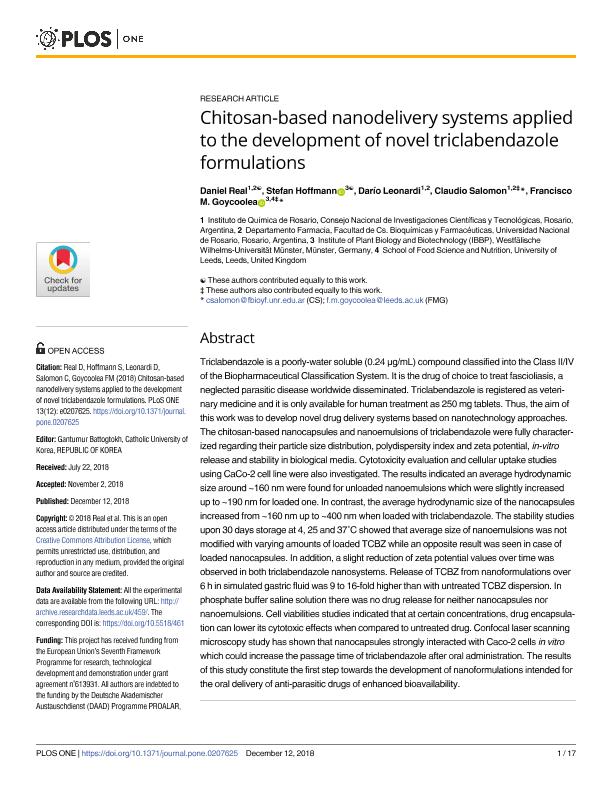Artículo
Chitosan-based nanodelivery systems applied to the development of novel triclabendazole formulations
Real, Daniel Andres ; Hoffmann, Stefan; Leonardi, Darío
; Hoffmann, Stefan; Leonardi, Darío ; Salomon, Claudio Javier
; Salomon, Claudio Javier ; Goycoolea, Francisco M.
; Goycoolea, Francisco M.
 ; Hoffmann, Stefan; Leonardi, Darío
; Hoffmann, Stefan; Leonardi, Darío ; Salomon, Claudio Javier
; Salomon, Claudio Javier ; Goycoolea, Francisco M.
; Goycoolea, Francisco M.
Fecha de publicación:
12/2018
Editorial:
Public Library of Science
Revista:
Plos One
ISSN:
1932-6203
Idioma:
Inglés
Tipo de recurso:
Artículo publicado
Clasificación temática:
Resumen
Triclabendazole is a poorly-water soluble (0.24 μg/mL) compound classified into the Class II/IV of the Biopharmaceutical Classification System. It is the drug of choice to treat fascioliasis, a neglected parasitic disease worldwide disseminated. Triclabendazole is registered as veterinary medicine and it is only available for human treatment as 250 mg tablets. Thus, the aim of this work was to develop novel drug delivery systems based on nanotechnology approaches. The chitosan-based nanocapsules and nanoemulsions of triclabendazole were fully characterized regarding their particle size distribution, polydispersity index and zeta potential, in-vitro release and stability in biological media. Cytotoxicity evaluation and cellular uptake studies using CaCo-2 cell line were also investigated. The results indicated an average hydrodynamic size around ∼160 nm were found for unloaded nanoemulsions which were slightly increased up to ∼190 nm for loaded one. In contrast, the average hydrodynamic size of the nanocapsules increased from ∼160 nm up to ∼400 nm when loaded with triclabendazole. The stability studies upon 30 days storage at 4, 25 and 37°C showed that average size of nanoemulsions was not modified with varying amounts of loaded TCBZ while an opposite result was seen in case of loaded nanocapsules. In addition, a slight reduction of zeta potential values over time was observed in both triclabendazole nanosystems. Release of TCBZ from nanoformulations over 6 h in simulated gastric fluid was 9 to 16-fold higher than with untreated TCBZ dispersion. In phosphate buffer saline solution there was no drug release for neither nanocapsules nor nanoemulsions. Cell viabilities studies indicated that at certain concentrations, drug encapsulation can lower its cytotoxic effects when compared to untreated drug. Confocal laser scanning microscopy study has shown that nanocapsules strongly interacted with Caco-2 cells in vitro which could increase the passage time of triclabendazole after oral administration. The results of this study constitute the first step towards the development of nanoformulations intended for the oral delivery of anti-parasitic drugs of enhanced bioavailability.
Palabras clave:
CHITOSAN
,
NANODELIVERY
,
TRICLABENDAZOLE
Archivos asociados
Licencia
Identificadores
Colecciones
Articulos(IQUIR)
Articulos de INST.DE QUIMICA ROSARIO
Articulos de INST.DE QUIMICA ROSARIO
Citación
Real, Daniel Andres; Hoffmann, Stefan; Leonardi, Darío; Salomon, Claudio Javier; Goycoolea, Francisco M.; Chitosan-based nanodelivery systems applied to the development of novel triclabendazole formulations; Public Library of Science; Plos One; 13; 12; 12-2018; 1-17
Compartir
Altmétricas



